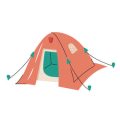Understanding Temperature Ratings: What Do They Really Mean?
If you’re planning a family camping trip in the U.S., choosing the right sleeping bag starts with understanding temperature ratings. These ratings can look confusing at first, but they’re key to ensuring everyone in your family stays warm and comfortable through the night. In simple terms, a sleeping bag’s temperature rating tells you the lowest temperature at which the bag is designed to keep an average sleeper warm. However, there are different types of ratings you’ll see—primarily comfort, limit, and extreme—and each one means something a bit different, especially when applied to real-life family camping situations across diverse American climates.
The comfort rating is usually the most important for families, as it indicates the temperature at which a person can sleep comfortably without feeling cold. This is typically based on a “cold sleeper,” often considered to be women or children, who may need more warmth during the night. The limit rating refers to the temperature at which an “average man” can sleep curled up without feeling too cold; this might be more relevant for experienced campers or those who know they tend to sleep hot. Lastly, the extreme rating marks the lowest temperature at which a person can survive for six hours without risk of hypothermia—but it’s not meant for comfort and certainly not ideal for family adventures.
When camping in the varied conditions of the U.S.—from chilly mountain mornings in Colorado to mild summer nights in Florida—it’s crucial to pick a sleeping bag with a comfort rating that matches the coldest temperatures you expect to face. For families, always err on the side of caution by prioritizing comfort over survival; kids especially will appreciate that extra layer of warmth! Understanding these basic ratings ensures your next camping trip is memorable for all the right reasons: happy, cozy nights under the stars.
2. Considering U.S. Regional Climates and Seasons
When planning a family camping trip or a solo adventure, understanding how the diverse climates across the United States influence your sleeping bag choice is key to a comfortable night outdoors. The U.S. spans several climate zones—from the rainy forests of the Pacific Northwest to the arid Southwest deserts, and the chilly peaks of the Rockies—each presenting unique temperature challenges for campers.
How Regions Impact Sleeping Bag Selection
Let’s break down some common U.S. camping regions and what they mean for your sleeping bag’s temperature rating:
| Region | Typical Conditions | Recommended Temperature Rating |
|---|---|---|
| Pacific Northwest | Cool, damp; rain frequent even in summer; temps can dip at night | 20–35°F (-6 to 1°C) for spring/fall 35–50°F (1 to 10°C) for summer |
| Southwest Deserts | Hot days, chilly nights; dry air causes rapid heat loss after sunset | 20–40°F (-6 to 4°C) for spring/fall 35–50°F (1 to 10°C) for summer |
| The Rockies & High Elevations | Unpredictable weather; cold nights year-round; snow possible even in summer | 0–20°F (-18 to -6°C) for early/late season 20–35°F (-6 to 1°C) for peak summer |
| Southeast & Midwest | Mild to hot summers; humidity high; surprise cold snaps possible in spring/fall | 30–50°F (-1 to 10°C) for spring/fall 40–60°F (4 to 16°C) for summer family camping |
| Northeast & Appalachians | Mild summers but cool, damp nights; autumn can be brisk | 20–40°F (-6 to 4°C) for most conditions Add a liner if expecting a cold front! |
Seasonal Considerations: Family vs. Solo Camping Needs
The time of year plays just as big a role as geography. For families, it’s smart to choose bags rated slightly lower than expected lows—kids tend to get colder faster! In spring and fall, overnight temps can swing dramatically, especially in mountains or deserts. Always check local forecasts and plan for sudden weather changes. For solo campers or teens who run “hot” or “cold,” personal comfort matters too—consider adjustable bags or layering with liners.
Pro Tip: Don’t Forget Microclimates!
Lakesides, valleys, and shaded forests often feel much cooler overnight than open campgrounds nearby. When in doubt, pick a bag rated at least 10 degrees colder than the forecasted low—better safe than shivering!

3. Factoring in Personal and Family Needs
When choosing the right temperature rating for your sleeping bags, it’s important to remember that everyone in your camping group—especially kids—will have unique comfort needs. Age, metabolism, and personal sleeping habits all play a big role in how warm or cool someone feels at night. Let’s break down what this means for families camping in the U.S.
Age Differences Matter
Children tend to lose body heat more quickly than adults, making them more susceptible to cold nights. If you’re camping with little ones, consider selecting sleeping bags rated at least 10°F warmer than the expected lowest nighttime temperature. Older adults may also feel the cold more intensely, so their needs should be considered as well.
Metabolism: Everyone’s Different
Some people naturally sleep warmer because of a faster metabolism, while others might always feel chilly—even under the same conditions. If someone in your family is known for “running cold,” opt for a bag with a lower temperature rating or plan on layering up inside the bag with extra clothing or liners.
Sleeping Habits and Comfort Preferences
Is your child a restless sleeper who often kicks off blankets? Do you or your partner prefer to sleep in minimal clothing? These habits can impact how well a sleeping bag works for each person. For active sleepers, consider a slightly warmer bag to compensate for tossed-aside covers. If your family is new to camping, err on the side of caution by picking bags that are rated for colder temperatures than you expect—its easier to cool down than warm up during the night.
By paying attention to these personal factors, you’ll make sure every member of your family stays cozy and comfortable throughout your camping adventure—no matter what Mother Nature has in store!
4. The Impact of Sleep System Components
When planning a camping trip in the U.S., it’s important to remember that your sleeping bag is only one piece of the sleep system puzzle. Several other components—like sleeping pads, liners, pajamas, and tents—play a significant role in keeping you warm throughout the night. Understanding how these items work together can help you select the most appropriate temperature rating for your sleeping bag, ensuring both comfort and safety no matter where your adventure takes you.
How Different Components Affect Warmth
The right combination of gear can make a big difference in how warm you feel at night. Here’s how each component contributes:
| Component | How It Influences Warmth |
|---|---|
| Sleeping Pad | Insulates you from cold ground; higher R-value pads are warmer |
| Liner | Adds extra warmth (5–15°F) to your sleeping bag; easy to wash and versatile |
| Pajamas/Sleepwear | Moisture-wicking, thermal layers help retain body heat and keep sweat away |
| Tent/Shelter | Blocks wind, traps some body heat, reduces exposure to outside temperatures |
Factoring Sleep System into Your Bag Choice
- If you use a high-quality sleeping pad with a high R-value (above 4), you may be comfortable with a slightly lighter sleeping bag rating than if you use a basic foam pad.
- Adding a liner can boost your sleeping bag’s effective temperature rating without adding much weight or bulk.
- Packing appropriate sleepwear for expected conditions helps maximize warmth and comfort.
- The type of tent or shelter impacts internal temperature; smaller tents generally retain more heat than large ones.
Example: Adjusting Your Temperature Rating
If you expect 40°F (4°C) nighttime lows but plan to use an insulated sleeping pad (R-value 5) and a liner (+10°F warmth), you might choose a 40°F-rated bag rather than a 20°F one, as your overall system will compensate for cooler temps. However, if youre car camping in unpredictable weather or with kids who chill easily, its wise to err on the side of caution and go for a lower-rated (warmer) sleeping bag.
Family Tip
When camping with children, remember they often get colder faster than adults. Always consider their entire sleep system—not just the bag—when planning for chilly nights.
5. Reading Real-World Reviews and Testing at Home
Choosing the right temperature rating for your family’s sleeping bags isn’t just about reading product specs; it’s also about learning from real experiences. Before making a purchase, take some time to read reviews written by other parents and families who have camped in similar U.S. climates. Look for feedback on how the sleeping bag performed during chilly nights or sudden weather changes. Local camping forums and community groups are great places to ask for honest opinions—many campers love sharing their tips and lessons learned!
It’s also smart to reach out directly to friends or neighbors who regularly camp in the area you plan to visit. They can offer valuable insights on what worked (or didn’t) for their kids and how they managed unexpected cold snaps.
Before heading out into the backcountry, why not do a fun trial run at home? Set up a backyard campout with your chosen sleeping bags. This hands-on test lets you see how warm and comfortable everyone feels overnight, and gives your kids a chance to get excited about the adventure ahead. If anyone wakes up chilly, you’ll have time to adjust your gear or add layers without any stress. Testing at home means you can make sure everyone is snug and ready for a cozy night under the stars—no surprises when you’re far from home!
6. Pro Tips for Staying Cozy and Safe
Keeping your family warm and safe during camping trips is about more than just picking the right sleeping bag—it’s also about preparation and awareness. Here are some heartfelt tips to ensure both kids and adults stay cozy under the stars, no matter what U.S. camping conditions bring.
Layer Up for Warmth
Encourage everyone to wear layers to bed. Think lightweight thermal underwear, wool socks, and a beanie or knit cap to keep body heat in. For little ones, avoid overdressing; too many layers can cause overheating or sweating, which actually makes you colder once moisture cools off.
Recognize Early Signs of Being Too Cold
It’s important to watch for early warning signs that someone is getting too chilly. Shivering, chattering teeth, pale or cool skin, and complaints of numb fingers or toes are red flags—especially in children. Remind kids to speak up if they feel cold so you can take action before it becomes serious.
What To Do If Conditions Change Unexpectedly
If temperatures drop lower than expected or a sudden chill sets in, don’t panic! Gather everyone together to share warmth, use extra blankets or towels as insulation inside sleeping bags, and make sure no one sleeps directly on the ground—use pads or even spare clothes for added insulation underneath. If someone is struggling to get warm, offer a warm drink (like cocoa) and consider turning on a portable heater if you’re at a developed campsite with power (always follow safety guidelines!).
Keep Spirits High
A big part of staying warm is keeping spirits up. Tell stories, sing songs, or play simple games while everyone gets settled for the night. The memories you make snuggled together will last long after the campfire dies down!
Remember: Safety First!
No adventure is worth risking anyone’s health. Always check weather forecasts before your trip, pack extra gear just in case, and don’t hesitate to move indoors if conditions become unsafe. With thoughtful planning and these practical tips, you’ll help your family enjoy magical nights outdoors—warm, safe, and full of happy memories.


